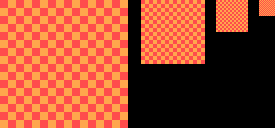Digital Images and Graphics
Digital pictures (images and graphics) are 2D representations of some information,
stored in digital form.
How We See
Light passes into the eye (through the pupil) onto the retina. Information
passes to the brain via the optic nerve.
Rods detect luminance (light levels)
Concentrated about the periphery
Works well even in low light
Cones detect color
Specialized cones: red, green, blue
Concentrated in the center
Needs more light to see
Read
more about this.
What We See
Our eyes pick up light waves (electro-magnetic radiation), which are perceived
as an image.
Frequency in the Visible Spectrum
Measured in nanometers (nm)
Humans can see wavelengths of 350-780 nm
Red = 700 nm
Green = 546 nm
Blue = 436 nm
Warm colors appear toward the infrared end of the spectrum (red, orange).
Cool colors appear toward the ultraviolet end of the spectrum (blue, violet).
White light = all colors added together (Red-Green-Blue primaries)
Perceived Color Attributes
Hue or Color: the predominant color
Saturation or Brightness: purity of the color
Value, Intensity or Lightness: quantity of light reflected or transmitted
Read more
about this.
Color Systems
Colors that we see may be reflected light (subtractive) or emitted light (additive).
Content on this page requires a newer version of Adobe Flash Player.
Color mixing
Primary colors are pure colors.
Secondary colors are mixtures of 2 primary colors.
The complement of a primary color is its opposite secondary color (i.e.
mix of other 2 primary colors).
Tertiary colors are mixtures of the primary colors with their complementary
secondary colors.
Additive colors show emitted light
Represented as RGB in computer
Examples: computer monitor, TV
Mixing colors makes them lighter
Subtractive colors show reflected light
Represented as CMYK for 4-color printing
Examples: printed pictures, paintings
Mixing colors makes them darker
Digital Color
Computer monitors display colors as additive mixes. Values (0..1)
represent relative strength of the color light.
Red Green Blue
Black
0
0
0
White
1
1
1
Grey
.5
.5
.5
Red
1
0
0
Green
0
1
0
Blue
0
0
1
Yellow
1
1
0
Cyan
0
1
1
Magenta
1
0
1
Pink
1
.5
.5
Orange
1
.5
0
Colors are represented by quantized (integer) values. Quantization determines
how many colors there are to work with.
Binary
one bit per pixel
color is either 0 (black) or 1 (white)
bitmaps commonly used for cursors and icons
can simulate grey scales with dithering
Grey scale
usually one byte per pixel
color ranges from 0 (black) to 255 (white)
RGB
fixed number of bits per color band
full color = 24-bit (one byte each for RGB)
RGBA has additional byte for transparency (alpha = A)
Color Maps
usually one byte per pixel (0..255)
pixel value corresponds to address in a color lookup table
color lookup table indicates full color for that value
standard color maps versus custom color maps
Read
more about this.
Digital Pictures
All digital pictures are ultimately drawn on a two-dimensional screen with fixed
dimensions. Sampling rate determines how much detail the picture can contain.
Aspect ratio
ratio of image width to image height
usually 4:3 (horizontal picture)
Resolution
amount of detail that may be reproduced
for raster displays, this is the number of pixel columns x rows
Coordinate system
maps pixels and points to screen locations
left-handed vs. right-handed systems
Visual Mix
Small spots of color next to each other are "mixed" in our brain,
so we perceive a single new color.
Visual mix allows us to see continuous color tones
Content on this page requires a newer version of Adobe Flash Player.
Display Hardware
The computer's display rapidly redraws a picture over and over again.
The picture that appears on the screen is stored in memory associated with
the display called the Frame Buffer
Resolution of the frame buffer indicates maximum detail that may be displayed
Depth of the frame buffer indicates how many bits are used to represent
a color
The picture drawn on the display fades quickly, allowing changes to be
made instantly
The refresh rate indicates how often the display redraws the picture (e.g.,
30 Hz or 60 Hz)
Read
more about this.
Vector vs. Raster Pictures
There are two basic ways of representing and displaying pictures with a
computer: vector and raster.
Raster images
Sample the electro-magnetic radiation at regular intervals
Each sample is assigned a quantized color value
Each sample corresponds to one pixel on the screen
Raster display re-draws every pixel
Advantages: flexibility (requires no underlying structure), supports subtle
color changes, simple to display
Disadvantages: resolution- and orientation-dependent, typically large files
Vector graphics
Pictures are represented by shapes composed of connected endpoints
Vector formats may also include faces (filled or unfilled) and curves
Endpoints may be multidimensional
Vector display re-draws the image at regular time intervals
Advantages: compact representation of underlying structure, transforms
well, can edit objects individually
Disadvantages: display processing times, subtle coloring changes
Read
more about this (view the first few pages only).
Digital File Formats
Numerous digital file formats are in use today, yet many have several things
in common
Header - contains information about the picture
Picture format (i.e. what fields occur where, and what they mean)
Resolution and quantization
Title, date, creation software, other annotations
Color lookup table
Data - the picture itself
ASCII data - large, but moves readily between systems
Binary data - beware of endian
Footer - supplements the header
Read
more about this.


